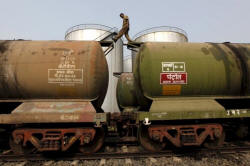|
Oil bulls aren't out of
the woods yet
 Send a link to a friend
Send a link to a friend
 [August 04, 2017]
By Amanda Cooper [August 04, 2017]
By Amanda Cooper
LONDON (Reuters) - Oil investors seem to
buy the idea that recovery is finally underway after three years of
gluts, but a price boom seems unlikely as the options market shows that
at least until OPEC's supply deal expires, producers will pounce on any
rallies.
The oil price <LCOc1> has gained about 20 percent in the last two months
to above $52 a barrel, doggedly posting higher highs and higher lows,
which would suggest this rally is more robust than the recoveries seen
in March and May this year.
"It has been a good rally since June but now crude oil has to prove that
it can break its downtrend channel," Petromatrix analyst Olivier Jakob
said.
Investors have been rattled by nagging doubt about the ability of the
Organization of the Petroleum Exporting Countries and its partners to
stick with a pledge to restrict output by 1.8 million barrels per day
until March, especially given resurgent output from Libya and Nigeria,
which are exempt.
A 10 percent rise in U.S. production this year and the painfully slow
decline in global oil inventories, which OPEC says must return to their
longer-term average before the output restriction can disappear, has fed
trader and investor scepticism.

Since OPEC and its 11 partners, including Russia, began curtailing
production in January, oil inventories across the world's most developed
nations have risen by around 40 million barrels and are still some 200
million barrels above their five-year average, OPEC's target.
However, year-on-year, inventories have fallen for two months in a row,
marking the first annual declines in stocks in over three years,
according to data from the U.S. Energy Information Administration.
The premium of oil for delivery in December this year compared with
December next year has fallen to just 62 cents, from nearly $2.50 at the
start of July.
The so-called "Dec/Dec" spread traded at an average premium of nearly
$4.00 a barrel from late 2014 to early this year, when that structure
turned negative after OPEC and its partners in late 2016 reached their
historic decision to cut supply.
But a seemingly relentless rise in global inventories and disenchantment
with OPEC's ability to rein in exports as well as output drove the
Dec/Dec spread to its widest in nine months by June.
PLENTY OF "VROOM" FOR IMPROVEMENT
The second half of the year typically marks a season of strong demand
for refined products as drivers take to the roads.

U.S. fuel inventories, the most visible, have fallen by around 10
percent since hitting record peaks earlier this year, but this trend
will have to continue to persuade longer-term investors, and OPEC
itself, that the long-awaited stock draw is truly underway.
[to top of second column] |

A worker walks atop a tanker wagon to check the freight level at an
oil terminal on the outskirts of Kolkata, India in this November 27,
2013 file photo. REUTERS/Rupak De Chowdhuri/Files

In the last month, funds have cut their combined bearish holdings of
Brent and West Texas Intermediate futures and options by more than 40
percent to their lowest in three months.
"U.S. crude oil inventories have started to seasonally decline, but I
think funds are probably going to wait and see where we stand at the end
of the summer before going long again," BNP Paribas head of commodity
strategy Harry Tchilinguirian said.
"Interestingly enough, OPEC too will be waiting for the end of the
summer to evaluate the impact of its supply cuts and judge what to do
for the balance of the period of output restraint that runs to March
next year."
There are a few warning signals still keeping investors cautious over
the resilience of this summer's rally.
One tell-tale sign of producers locking in their future oil sales, which
can dampen price rallies, is an increase in implied volatility on sell,
or put, options relative to that for buy, or call options.
Implied volatility is one way of measuring how popular an option is at
any given time.
The difference in implied volatility for put options with strike prices
that are close to the current underlying Brent futures price expiring in
six months' time over that for calls has reached its largest in two
months.

It hit a one-year low shortly after OPEC and its partners agreed in May
to extend their supply deal to March 2018.
"Front-month crude oil prices are currently trending higher, buoyed by
robust seasonal product demand, and tentative evidence that OECD stocks
may be drawing closer to their five-year average. On the back of this
trend ... longer-dated options continue to meet sustained producer
hedging," Societe Generale said in a note.
Goldman Sachs equity analysts, who expect the global oil market to show
a surplus next year when new projects come on stream, said recent stock
draws were a good start.
"But we believe additional datapoints – particularly from OECD
inventories – are needed, and we are not out of the woods yet."
(Reporting by Amanda Cooper; Editing by Veronica Brown and Dale Hudson)
[© 2017 Thomson Reuters. All rights
reserved.] Copyright 2017 Reuters. All rights reserved. This material may not be published,
broadcast, rewritten or redistributed. |